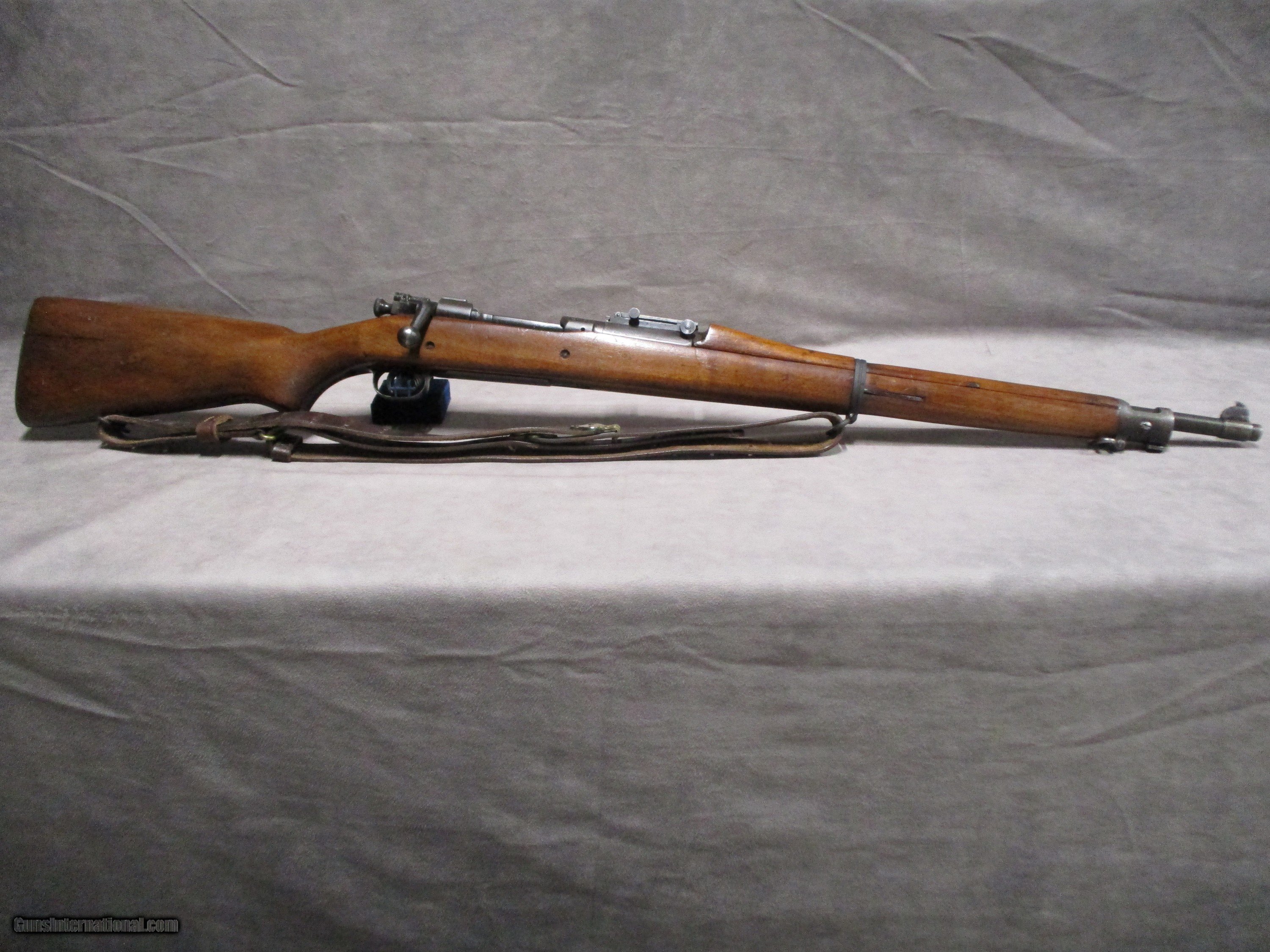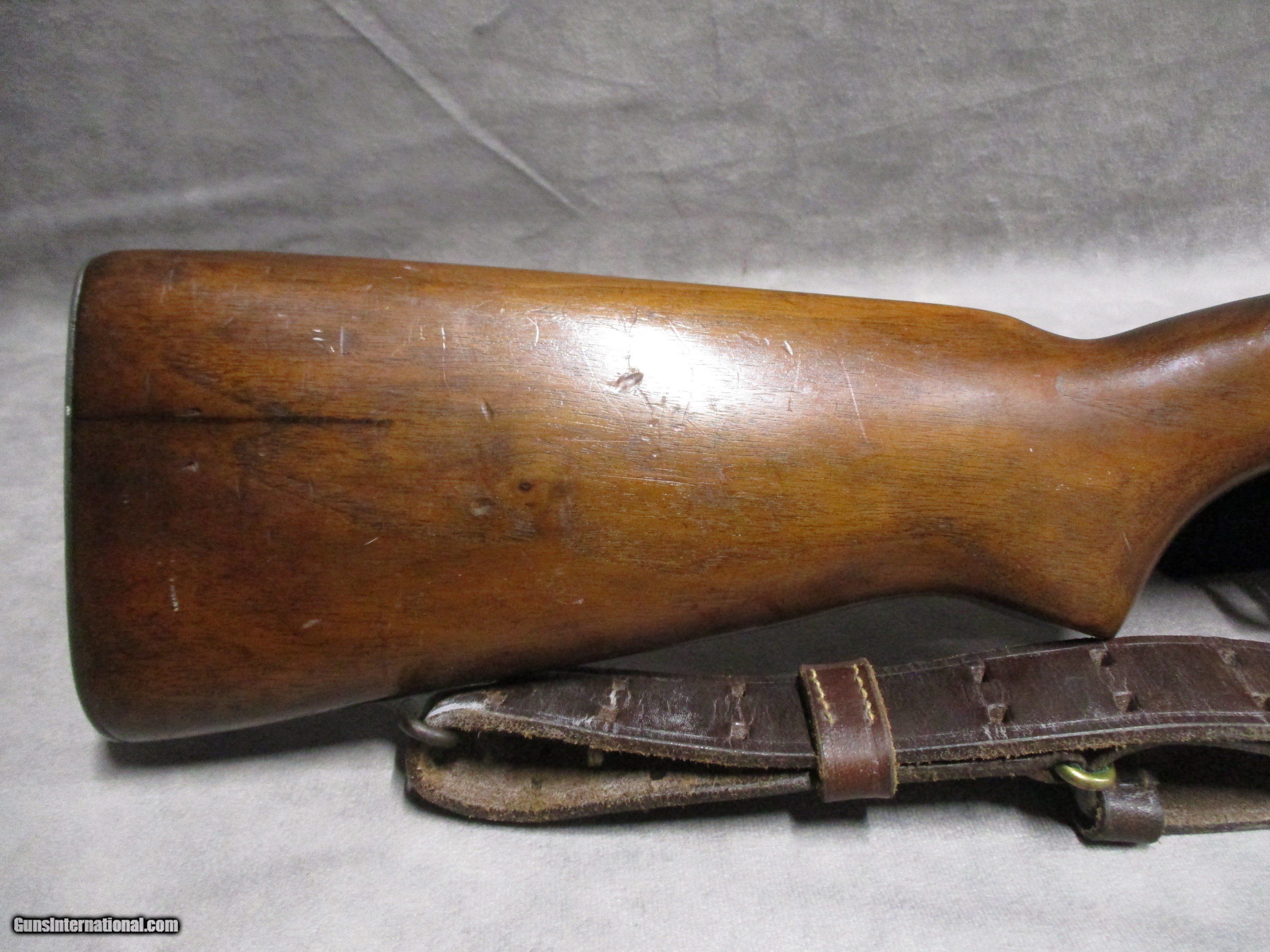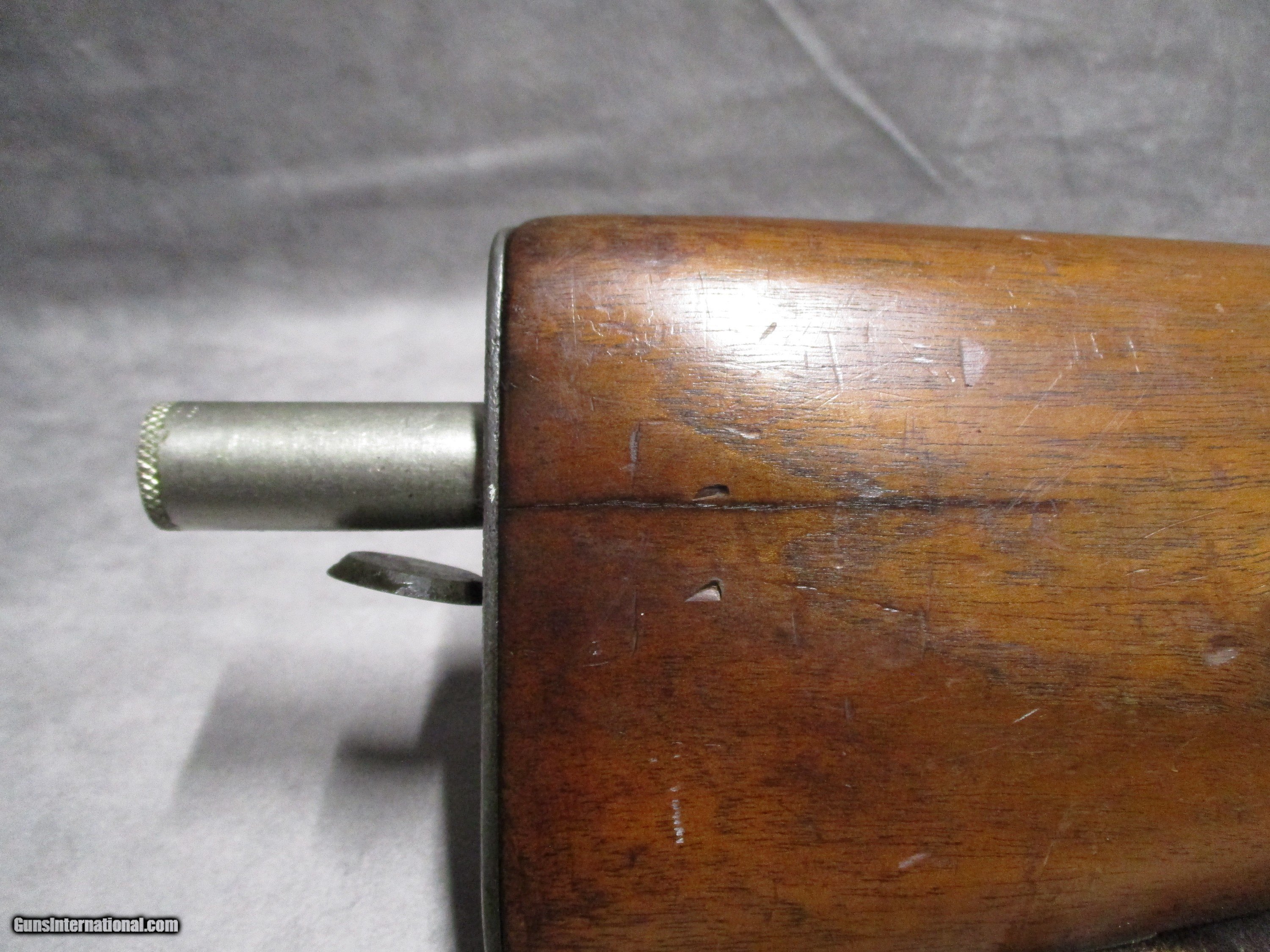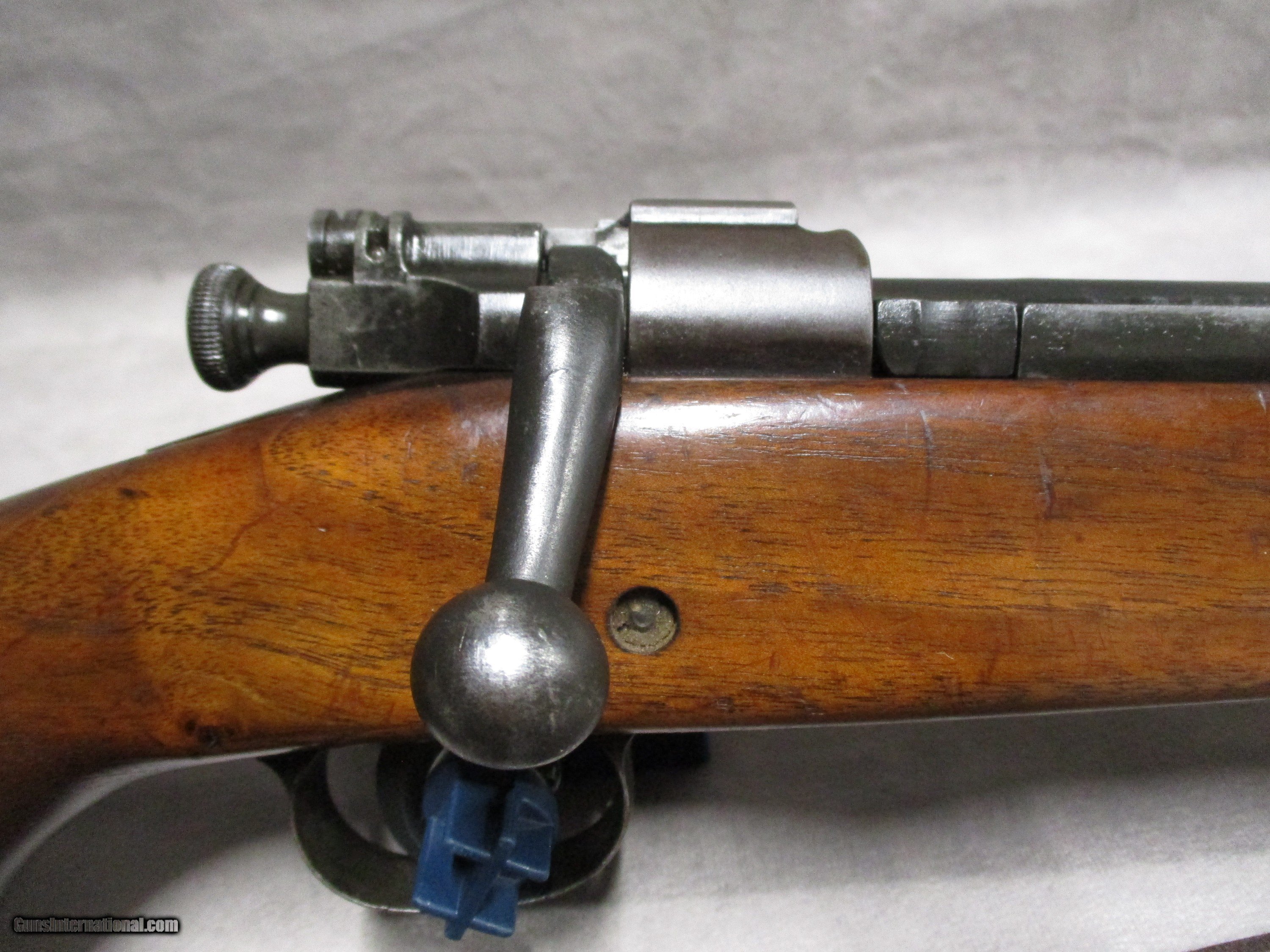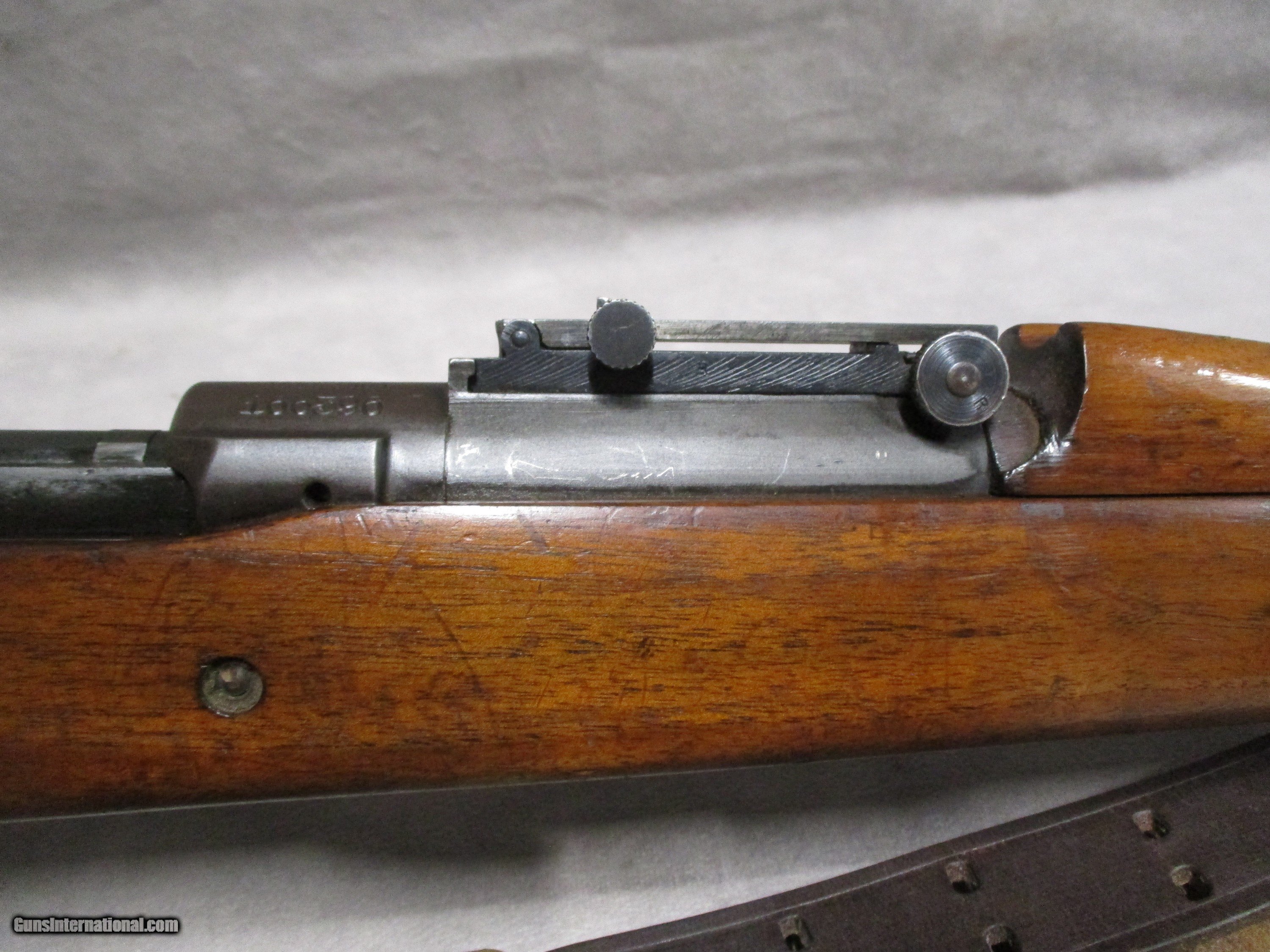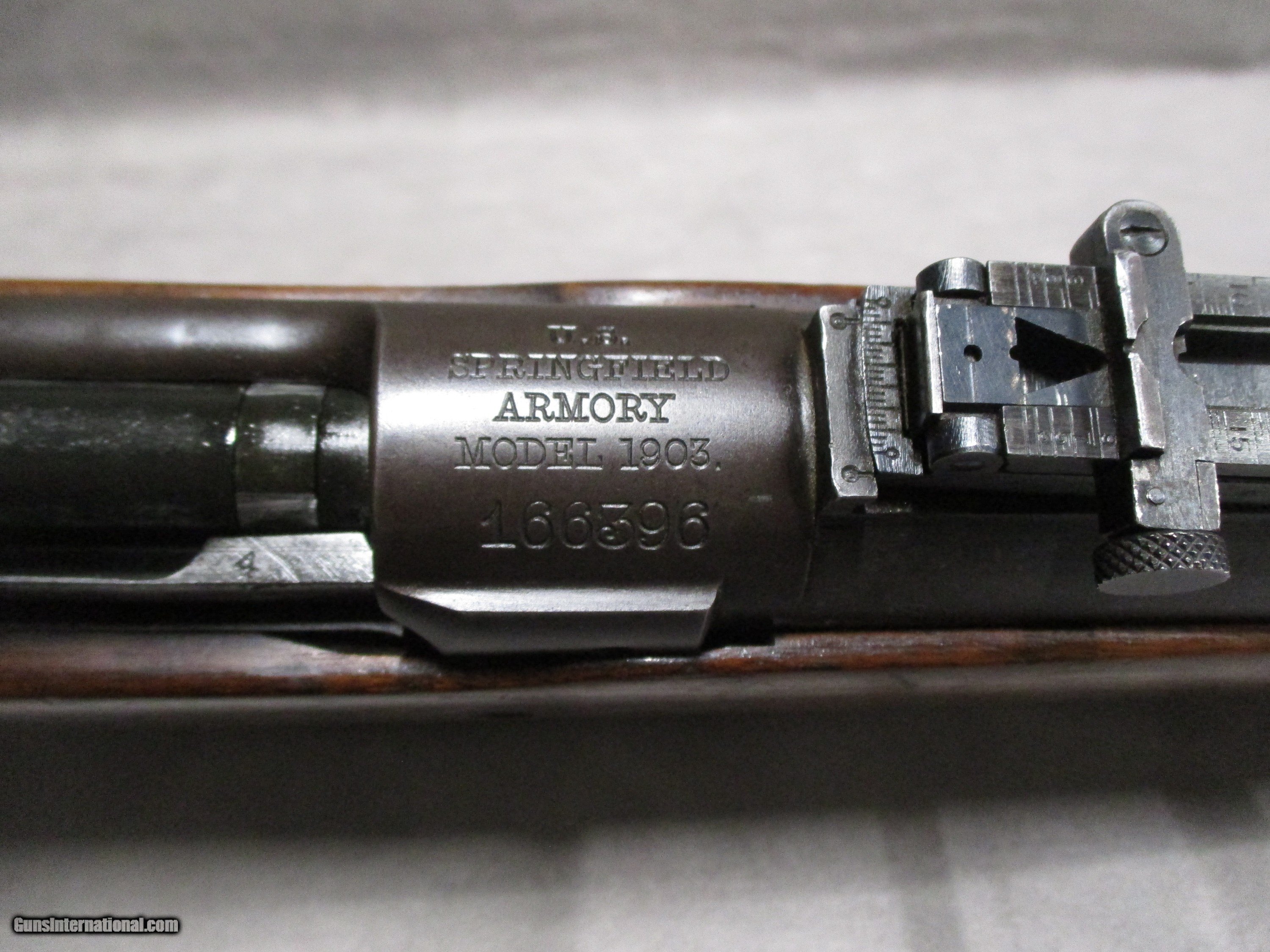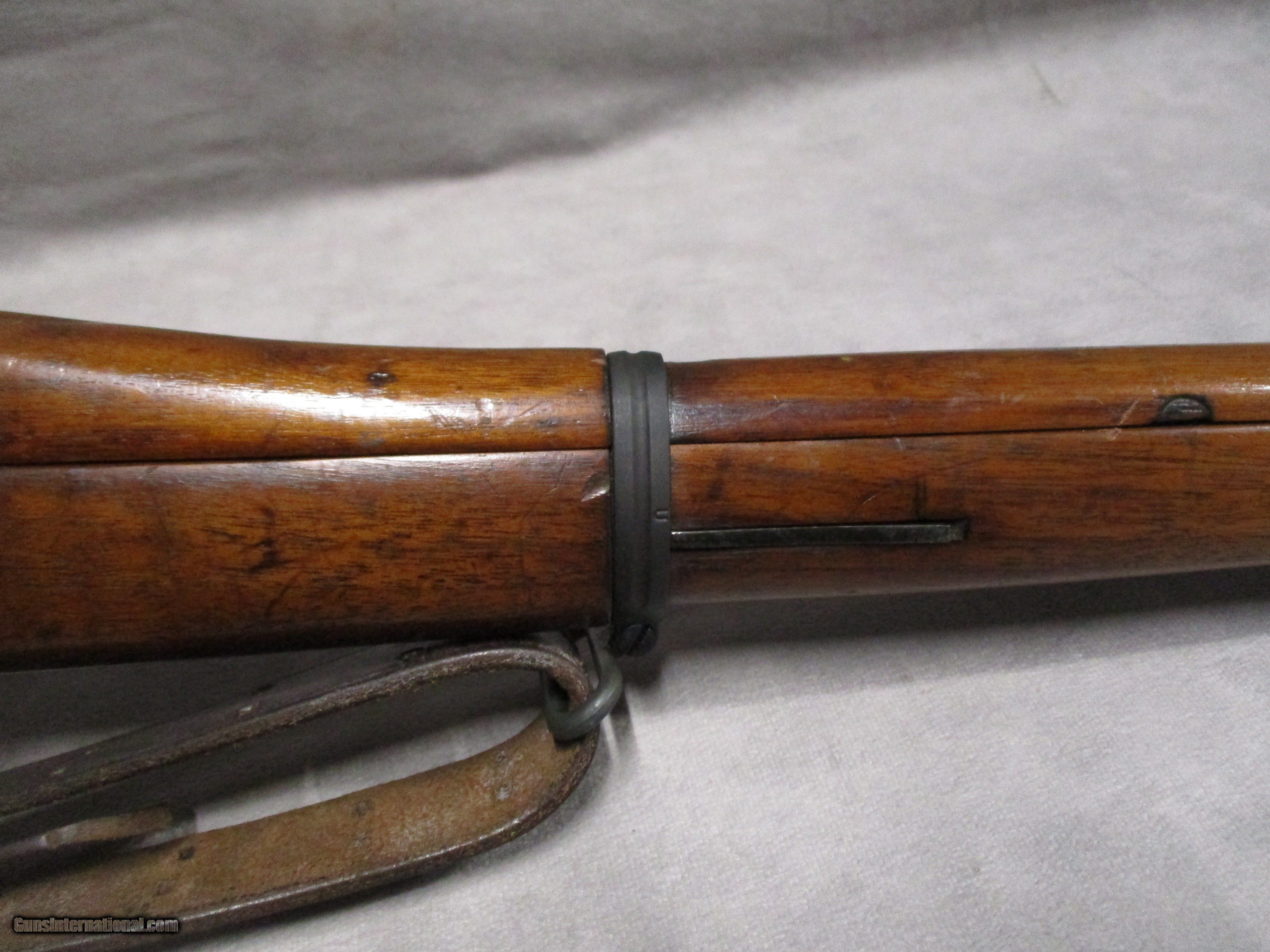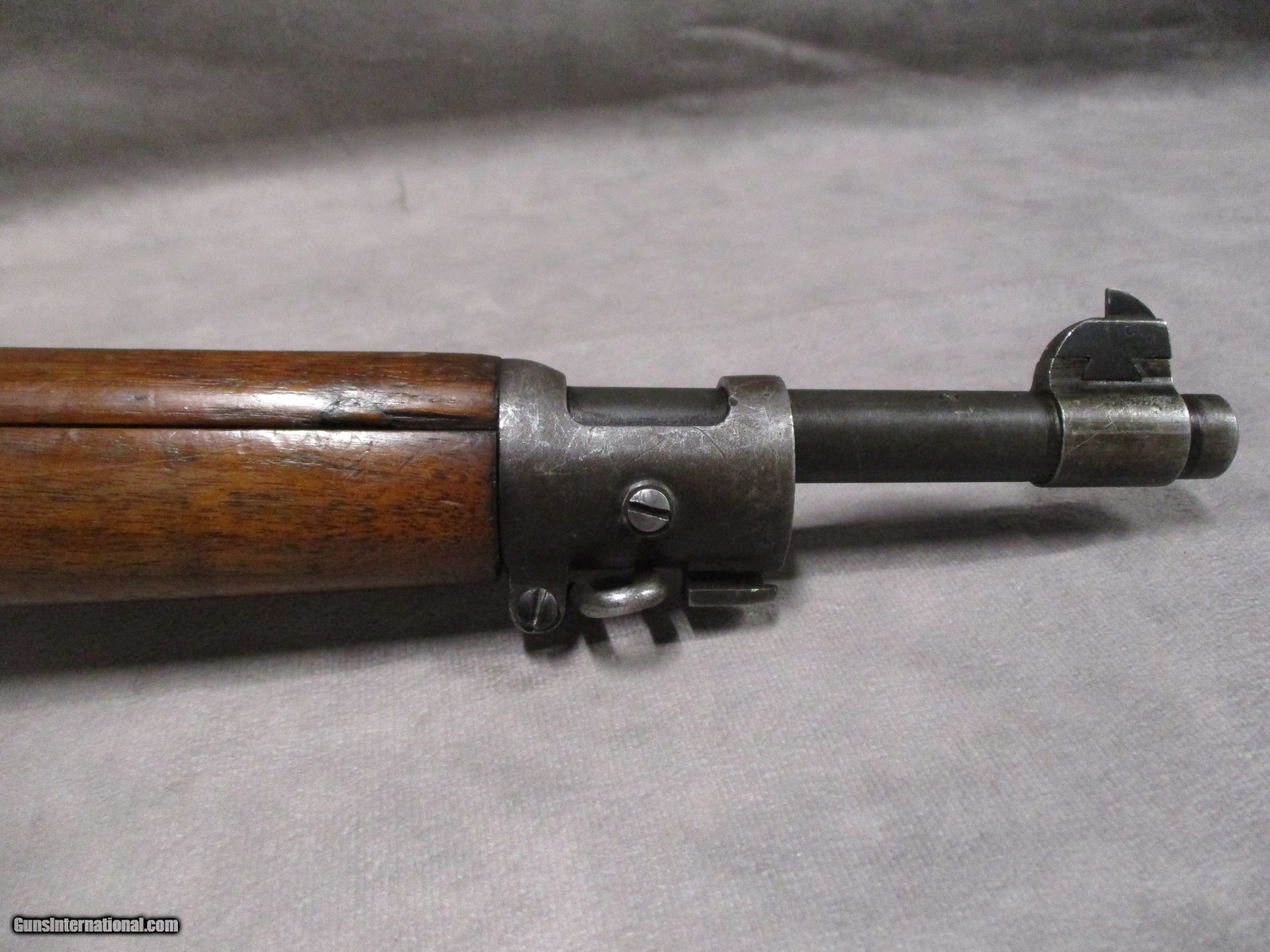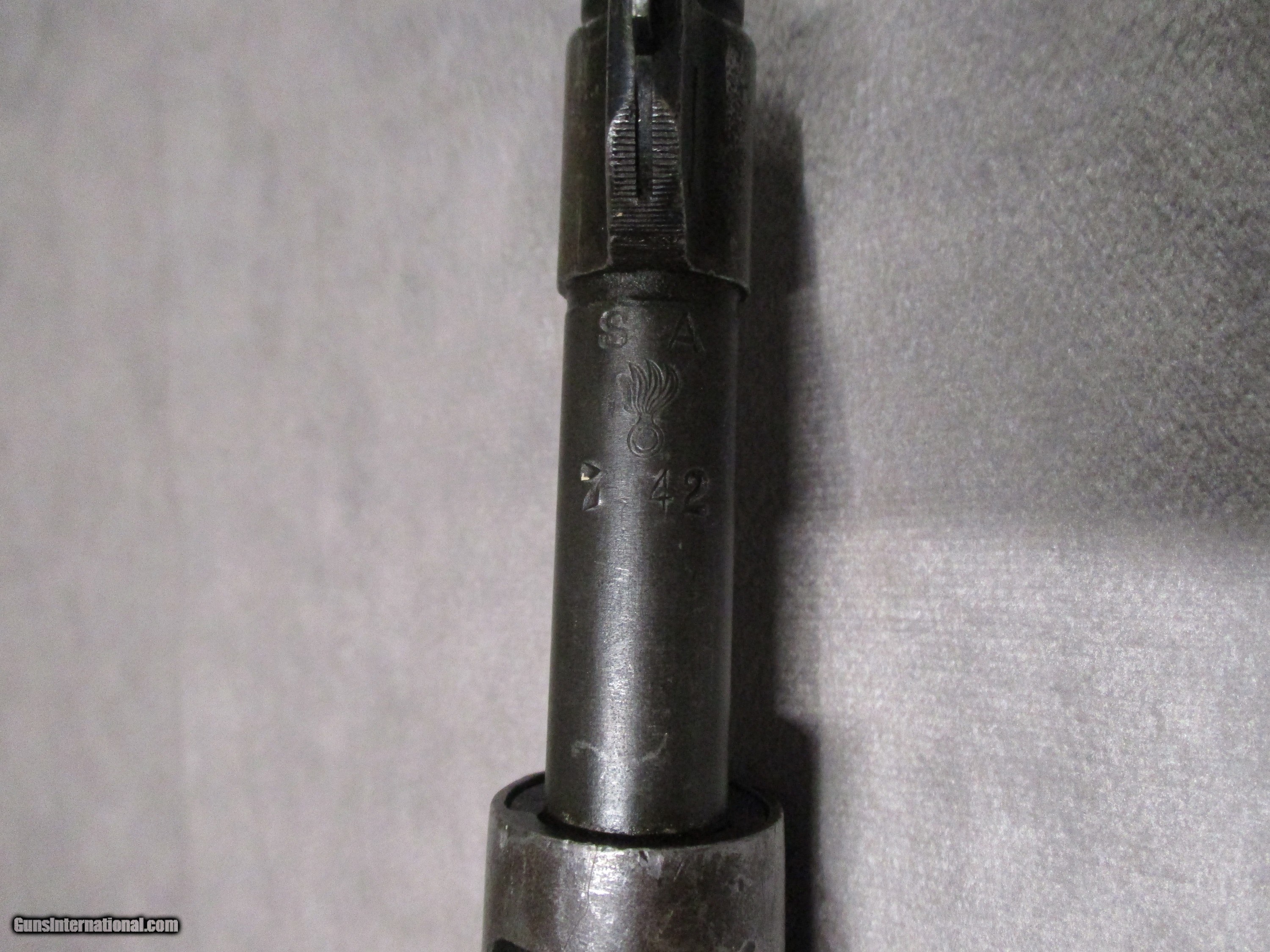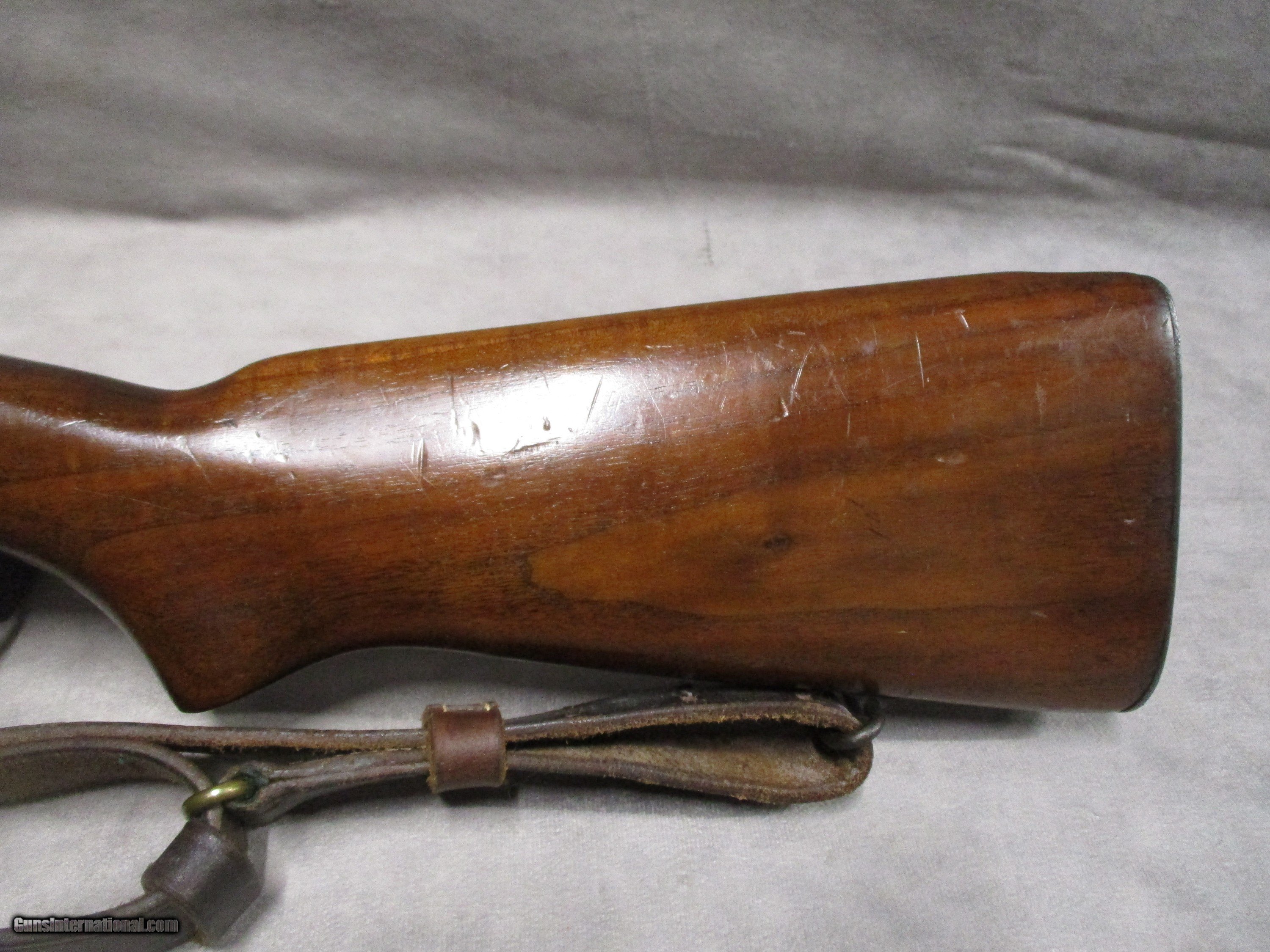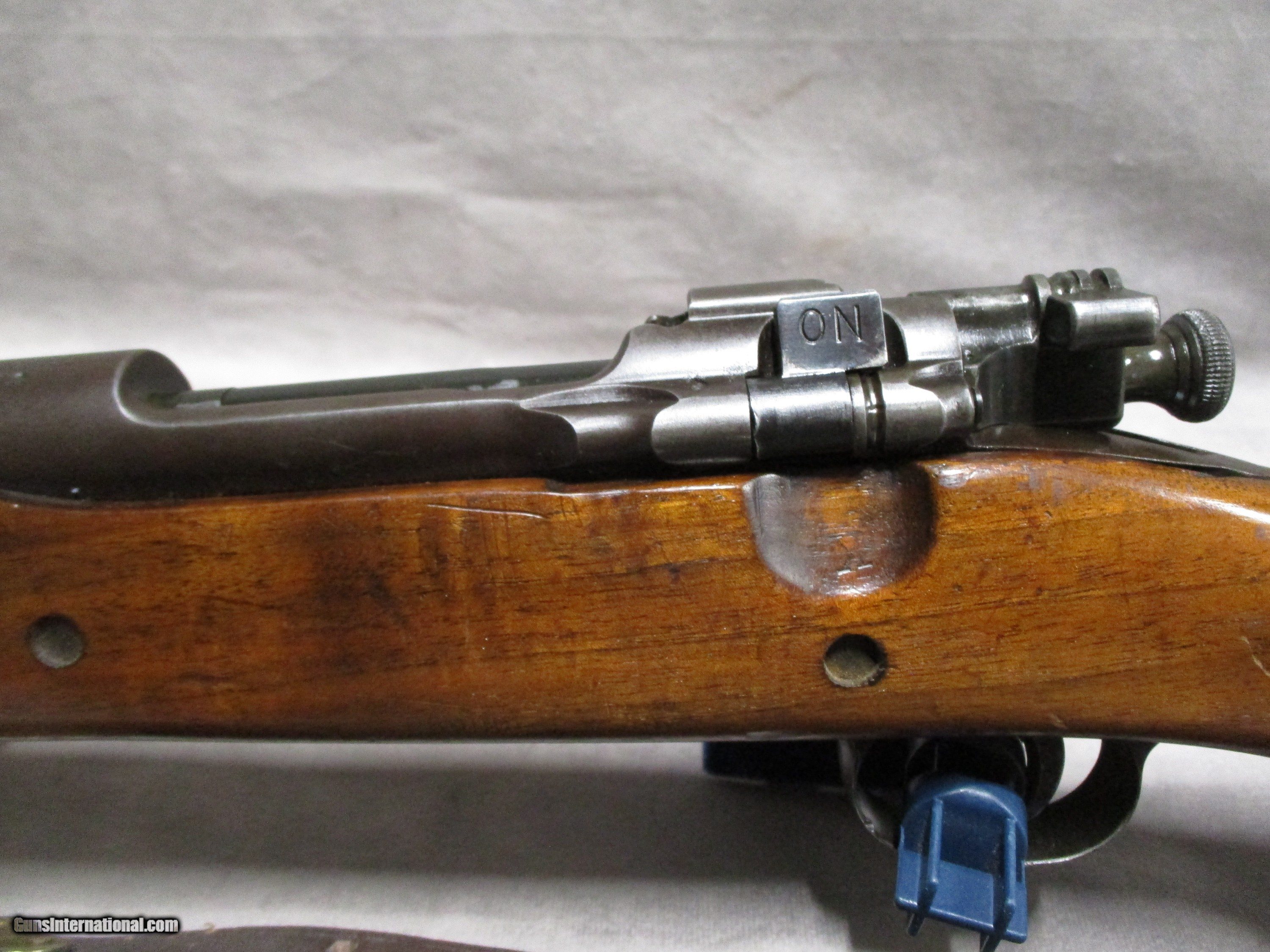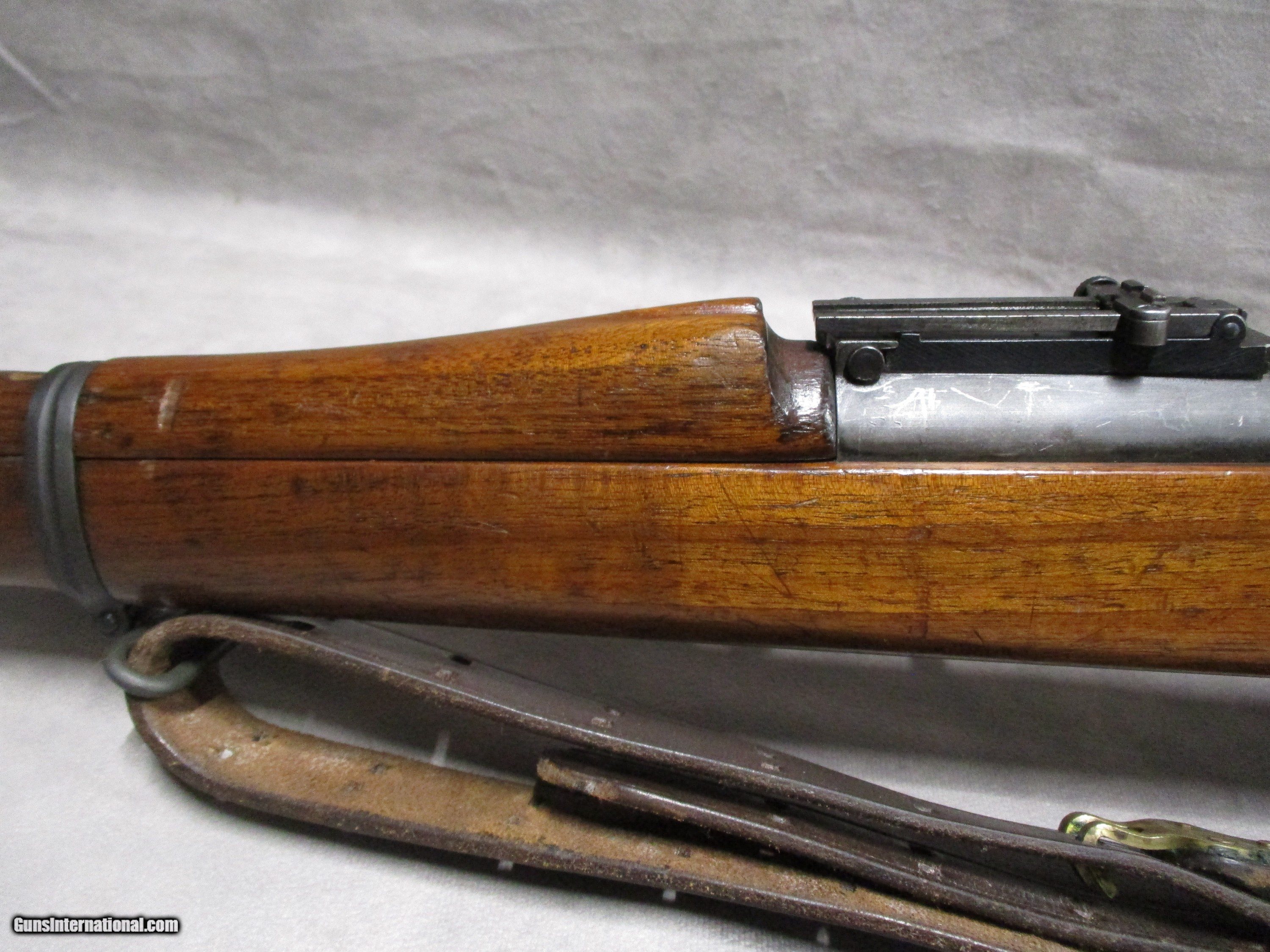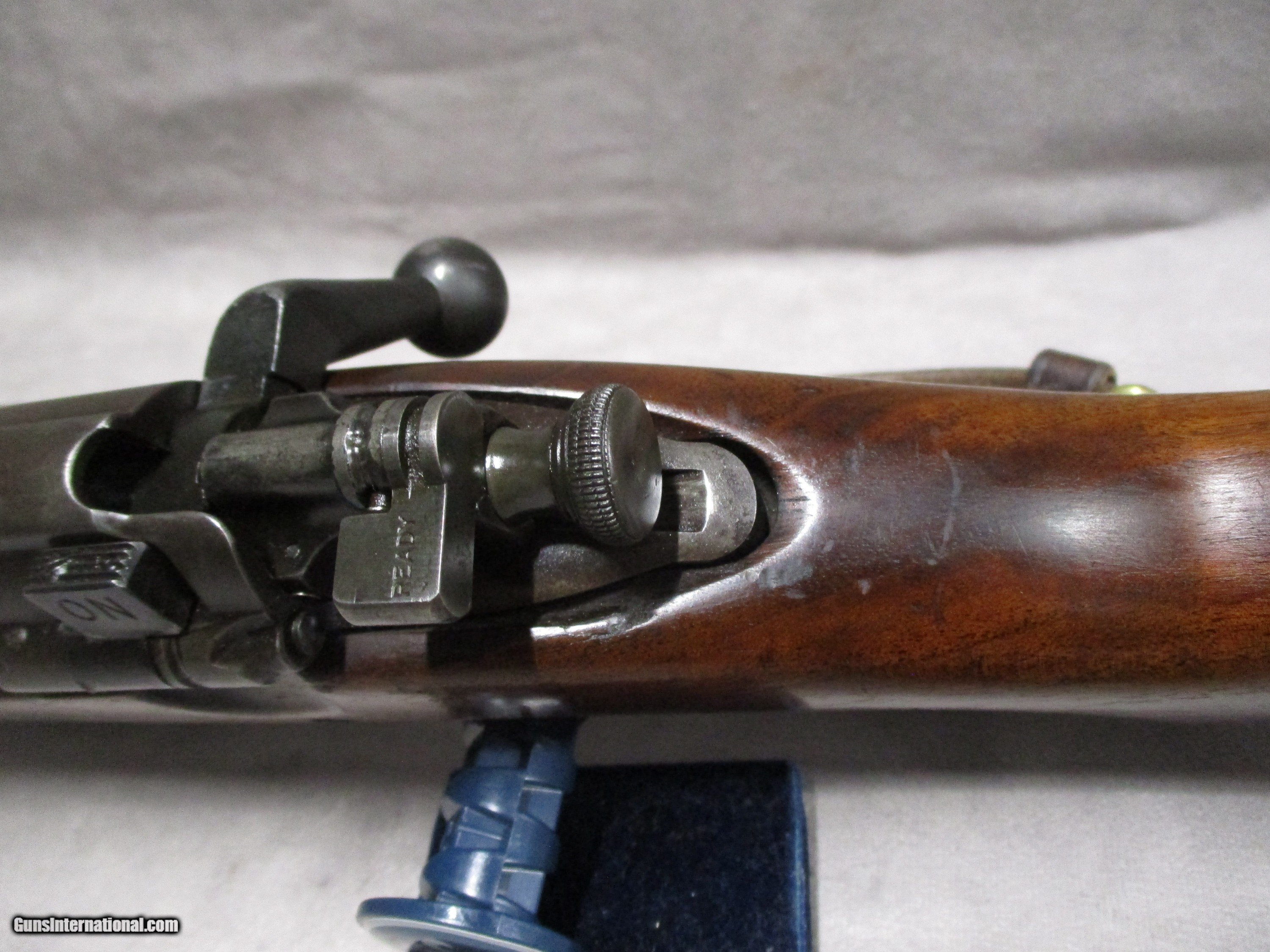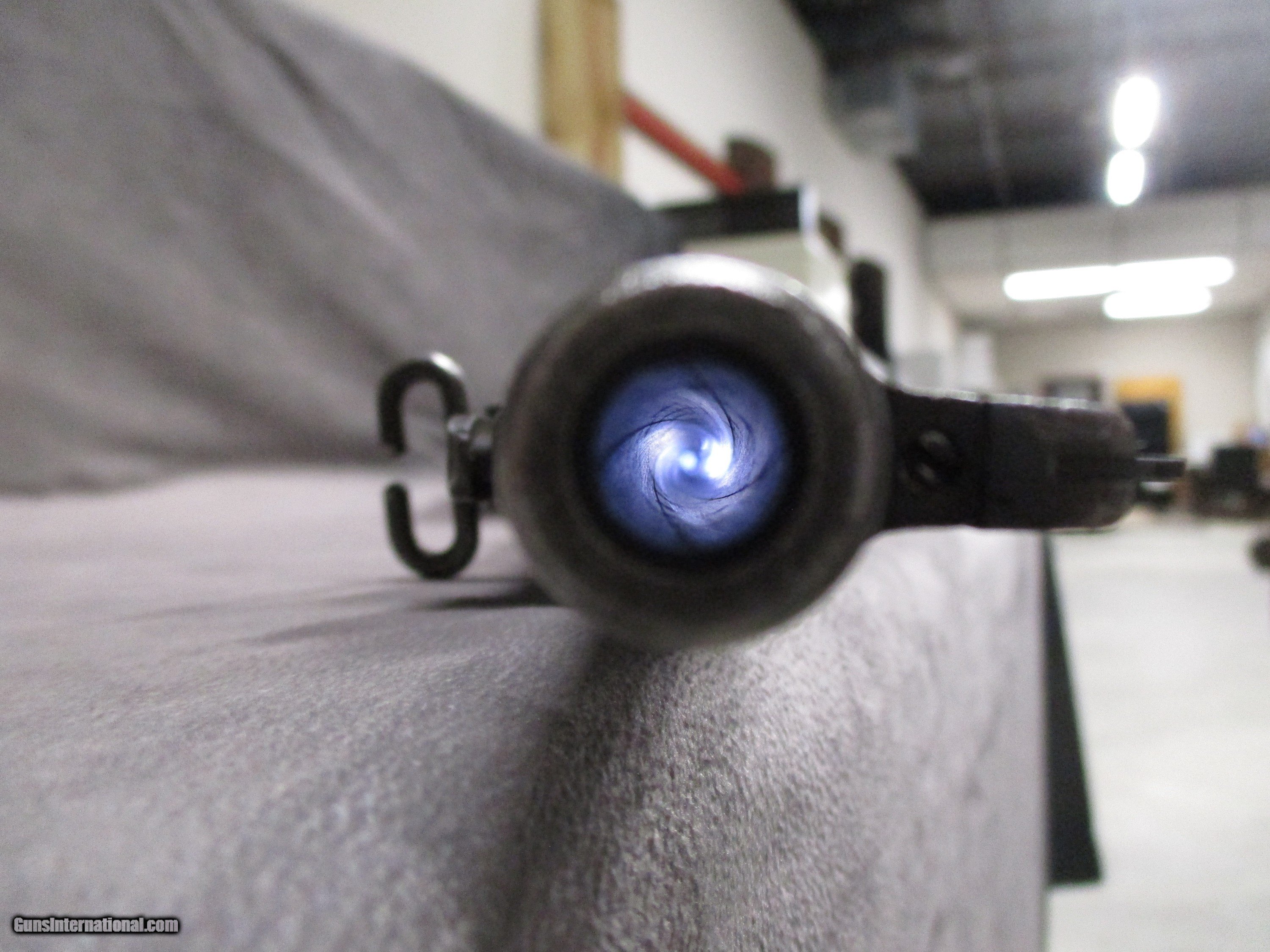Your Session is Ending
 The server has not detected any activity for the last 3 hours.
For your security, your session will expire in 2 minutes and you will be redirected to the Sign In page.
Would you like to stay signed in?
The server has not detected any activity for the last 3 hours.
For your security, your session will expire in 2 minutes and you will be redirected to the Sign In page.
Would you like to stay signed in?
Springfield Model 1903 Low-Serial Number (1906) WW2 Rebuild with Sling, Cleaning Kit
Springfield Model 1903 Low-Serial Number (1906) WW2 Rebuild with Sling, Cleaning Kit
Guns International #: 102529453
Seller's Inventory #: 2312-0068
Category - Springfield Rifles - 1903
- Military Rifles - US
Seller's Information
When emailing or calling sellers direct,
please mention that you saw their listing on GunsInternational.com
Seller: Shooter's Supply, LLC.
Member Since: 3/16/16
First Name: Patrick
Last Name: Brown
State:
Tennessee
Zip: 37343
Country: United States
Phone:
(423) 875-4868
Active Listings: 76
Total Listings: 1350
Seller Type: FFL Dealer
Return Policy: 3 day inspection and return policy on used guns and accessories. No returns on new firearms.
We normally ship USPS Priority Mail which should be 2-day ship. Shipping is actual cost with a minimum of $30.00 for pistols and $50.00 for rifles/shotguns to ship to most of the 48 contiguous states. Shipping to Alaska may require an extra fee. Shipping insurance is available upon request for an extra fee. We cannot do international sales. As of November 2019, we no longer ship guns to California and Hawaii.
We normally ship USPS Priority Mail which should be 2-day ship. Shipping is actual cost with a minimum of $30.00 for pistols and $50.00 for rifles/shotguns to ship to most of the 48 contiguous states. Shipping to Alaska may require an extra fee. Shipping insurance is available upon request for an extra fee. We cannot do international sales. As of November 2019, we no longer ship guns to California and Hawaii.
Payment Methods: Visa, Master Card, American Express, USPS Money Order. NO CREDIT CARD FEES!!!
About Us: We are a small family owned business located in Hixson, Tennessee. Do you have firearms at home collecting dust? We have a lively consignment business. Our fee is 20% with a $50 minimum. Firearms are consigned for a an average period of 180 days but the length of period is negotiable. We also do handgun carry permit classes for the state of Tennessee. We have a nice indoor shooting range with reasonable rates. Please check us out at shooterssupply.
Springfield Model 1903 Low-Serial Number (1906) WW2 Rebuild with Sling, Cleaning Kit
Description:
The Model 1903 Springfield rifle was designed to replace the U.S. Army’s Krag Rifle in service. It was built around the one-size-fits-all concept, and so did not have a cavalry/artillery specific model as did the Krag rifle. The M1903 was originally chambered for the .30-03 cartridge, which featured a 64.5mm long case and a 220gr round-nosed bullet. With the introduction of the German 8mm S Patrone and its 154gr Spitzgeschoss or Spire Point Bullet, the US had to follow suit and by 1906 the .30-06 was born (with its 150gr spitzer bullet and slightly shorter 63mm case length). As the Springfield was essentially a Mauser 1898 with a small ring receiver, royalties were paid to Mauser up until the U.S. declared war on Germany in 1917. By the time the US entered WW1 in 1917, 843,239 M1903 rifles had been produced at the Springfield Armory and Rock Island Arsenal.
Prior to the entry into war, it had been discovered that the production of the M1903 utilized questionable metallurgy. Some of the receivers constructed using the single-heat-treated method using case-hardened steel were improperly subjected to temperatures well above what was required during the forging process. Essentially, the carbon would be “burnt” out of the steel, resulting in an exceptionally brittle receiver. Contrary to popular belief, while there is documented evidence indicating some early receivers were improperly forged, actual cases of receivers self-destructing were very rare. Although some cases of serious injury resulting from a receiver failing during firing are documented, the U.S. Army never reported any fatalities. Indeed, a large number of the failures were not solely due to the quality of the receiver’s construction, but in fact to what was being loaded into the rifle. Some of the failures were linked to the use of incorrect cartridges such as the 8x57 Mauser. There is also evidence that Winchester may have significantly overloaded some of the .30-06 ammo they produced during the war. Nonetheless, pyrometers were installed in December of 1917 to more accurately measure temperatures during the forging process. The process of heating and quenching the steel was changed as well. This change was made at serial number 800,000 for rifles made at the Springfield Armory and at serial number 285,507 at the Rock Island Arsenal. Rifles with serial numbers lower than 800,000 are commonly referred to as “low-number” 1903s and while those above are termed “high-number” 1903s. The high-number 1903s are said to have been “double-heat treated” which refers to the newer heating/quenching process. Another change was made at serial number 1,275,767 with the introduction of nickel steel, replacing the WD 1325 steel used previously. While the likelihood of failure was low, the low-number 1903s still posed a potential safety risk, and the Ordnance Department withdrew as many of the low-number M1903s as they could find and stored them away. During World War 2, however, the urgent need for rifles resulted in the Ordnance Department’s decision to rebuild and reissue many of the low-number Springfields as well as the high-number ones. Sadly, as is usually the case with rebuilds involving large numbers of guns, the bolts tended to become mixed up during the process. However, telling the difference between a high-number bolt and a low-number bolt is easy. The original low-number bolt features a bolt handle which points directly downward or perpendicular to the length of the receiver. High number bolts, however, feature a bolt handle that is swept backwards at a slight angle. While some of the early high-number receivers came with the vertical bolt, NONE of the low-number receivers came with a swept-back bolt handle when they were originally built. Another major change made to the low-number guns during rebuilding was the replacement of the original straight-grip stock with the newer “Type C” wooden stock with pistol grip. As the rifles were required to be sent out as quickly as possible, the work done for the Type C stock to fit a low-number gun was usually a little crude, with small gaps between the tangs (upper and lower) and the stock itself. The original barrel might also be replaced with a newer one during the rebuild.
The rifle shown here is of course one of the low-number rifles rebuilt during World War 2. The receiver was built originally in 1906, the year the .30-06 Springfield and its spitzer bullet replaced the older .30-03 and its 220gr round-nosed bullet. The wear and tear on this rifle is consistent with one that has been used overseas. The barrel was a replacement made by Springfield Armory in July of 1942. The bore of the barrel is in good shape; there are a few miniscule spots of pitting visible near the muzzle, but they are mostly shallow and should not have that much effect on the accuracy of the rifle. The bolt is unsurprisingly a high-number type, given the swept-back bolt handle. The Type C stock has dings and a few dents here and there, and there are gaps behind the receiver tangs although the lower gap is smaller than the one on the top. Please see the pictures. The receiver is in no way loose in the stock, but the appearance is certainly unusual for a an M1903. The letter “K” is stamped into the recess for the magazine cutoff switch. This is the only stamp that can be visibly seen on the stock, so it is likely the stock was refinished at some point. The buttstock has a slim crack on the right-hand side that does NOT appear to have passed through to the other side. Repairing this should be fairly straightforward. The receiver, thankfully, has NOT been drilled and tapped. The condition of the 03’s finish is what would be expected of a rifle that saw service during wartime. There is a set of scratches on the rear sight collar. The rifle appears to have been cleaned of any rust on the external surfaces. There is a cleaning kit tube in the butt stock storage space. The leather sling is stamped “Hoyt 1917”, and its appearance encourages the belief that it is at least original to the era if not original to the rifle.
SOLD
Rifle Caliber: .30-06 Springfield
Manufacturer: Springfield Arsenal
Model: Model 1903
Serial Number: 166396
Bore: Rifled, 4 grooves, 1:10 inches (1 in 254 mm) RH twist
Ejectors: Manual ejection via operation of the bolt
Condition: Used - Good
Barrels: Nickel steel
Barrel Type: WW2 4-groove type
Action: Bolt action, Mauser ’98-style action with CRF
Triggers: Standard M1903 trigger
Stock: Type C wooden stock
Fore End: Wood
Butt Pad: Metal plate with trap door
LOP: 13.0 inches (330 mm)
Finish: Parkerized
Weight: 8.0 lbs. unloaded
Sights: M1905 Ladder type rear sight, blade front sight, sight radius 21.625 inches (549.275 mm)
Manufacture Date: 1906
Description:
The Model 1903 Springfield rifle was designed to replace the U.S. Army’s Krag Rifle in service. It was built around the one-size-fits-all concept, and so did not have a cavalry/artillery specific model as did the Krag rifle. The M1903 was originally chambered for the .30-03 cartridge, which featured a 64.5mm long case and a 220gr round-nosed bullet. With the introduction of the German 8mm S Patrone and its 154gr Spitzgeschoss or Spire Point Bullet, the US had to follow suit and by 1906 the .30-06 was born (with its 150gr spitzer bullet and slightly shorter 63mm case length). As the Springfield was essentially a Mauser 1898 with a small ring receiver, royalties were paid to Mauser up until the U.S. declared war on Germany in 1917. By the time the US entered WW1 in 1917, 843,239 M1903 rifles had been produced at the Springfield Armory and Rock Island Arsenal.
Prior to the entry into war, it had been discovered that the production of the M1903 utilized questionable metallurgy. Some of the receivers constructed using the single-heat-treated method using case-hardened steel were improperly subjected to temperatures well above what was required during the forging process. Essentially, the carbon would be “burnt” out of the steel, resulting in an exceptionally brittle receiver. Contrary to popular belief, while there is documented evidence indicating some early receivers were improperly forged, actual cases of receivers self-destructing were very rare. Although some cases of serious injury resulting from a receiver failing during firing are documented, the U.S. Army never reported any fatalities. Indeed, a large number of the failures were not solely due to the quality of the receiver’s construction, but in fact to what was being loaded into the rifle. Some of the failures were linked to the use of incorrect cartridges such as the 8x57 Mauser. There is also evidence that Winchester may have significantly overloaded some of the .30-06 ammo they produced during the war. Nonetheless, pyrometers were installed in December of 1917 to more accurately measure temperatures during the forging process. The process of heating and quenching the steel was changed as well. This change was made at serial number 800,000 for rifles made at the Springfield Armory and at serial number 285,507 at the Rock Island Arsenal. Rifles with serial numbers lower than 800,000 are commonly referred to as “low-number” 1903s and while those above are termed “high-number” 1903s. The high-number 1903s are said to have been “double-heat treated” which refers to the newer heating/quenching process. Another change was made at serial number 1,275,767 with the introduction of nickel steel, replacing the WD 1325 steel used previously. While the likelihood of failure was low, the low-number 1903s still posed a potential safety risk, and the Ordnance Department withdrew as many of the low-number M1903s as they could find and stored them away. During World War 2, however, the urgent need for rifles resulted in the Ordnance Department’s decision to rebuild and reissue many of the low-number Springfields as well as the high-number ones. Sadly, as is usually the case with rebuilds involving large numbers of guns, the bolts tended to become mixed up during the process. However, telling the difference between a high-number bolt and a low-number bolt is easy. The original low-number bolt features a bolt handle which points directly downward or perpendicular to the length of the receiver. High number bolts, however, feature a bolt handle that is swept backwards at a slight angle. While some of the early high-number receivers came with the vertical bolt, NONE of the low-number receivers came with a swept-back bolt handle when they were originally built. Another major change made to the low-number guns during rebuilding was the replacement of the original straight-grip stock with the newer “Type C” wooden stock with pistol grip. As the rifles were required to be sent out as quickly as possible, the work done for the Type C stock to fit a low-number gun was usually a little crude, with small gaps between the tangs (upper and lower) and the stock itself. The original barrel might also be replaced with a newer one during the rebuild.
The rifle shown here is of course one of the low-number rifles rebuilt during World War 2. The receiver was built originally in 1906, the year the .30-06 Springfield and its spitzer bullet replaced the older .30-03 and its 220gr round-nosed bullet. The wear and tear on this rifle is consistent with one that has been used overseas. The barrel was a replacement made by Springfield Armory in July of 1942. The bore of the barrel is in good shape; there are a few miniscule spots of pitting visible near the muzzle, but they are mostly shallow and should not have that much effect on the accuracy of the rifle. The bolt is unsurprisingly a high-number type, given the swept-back bolt handle. The Type C stock has dings and a few dents here and there, and there are gaps behind the receiver tangs although the lower gap is smaller than the one on the top. Please see the pictures. The receiver is in no way loose in the stock, but the appearance is certainly unusual for a an M1903. The letter “K” is stamped into the recess for the magazine cutoff switch. This is the only stamp that can be visibly seen on the stock, so it is likely the stock was refinished at some point. The buttstock has a slim crack on the right-hand side that does NOT appear to have passed through to the other side. Repairing this should be fairly straightforward. The receiver, thankfully, has NOT been drilled and tapped. The condition of the 03’s finish is what would be expected of a rifle that saw service during wartime. There is a set of scratches on the rear sight collar. The rifle appears to have been cleaned of any rust on the external surfaces. There is a cleaning kit tube in the butt stock storage space. The leather sling is stamped “Hoyt 1917”, and its appearance encourages the belief that it is at least original to the era if not original to the rifle.
SOLD
Rifle Caliber: .30-06 Springfield
Manufacturer: Springfield Arsenal
Model: Model 1903
Serial Number: 166396
Bore: Rifled, 4 grooves, 1:10 inches (1 in 254 mm) RH twist
Ejectors: Manual ejection via operation of the bolt
Condition: Used - Good
Barrels: Nickel steel
Barrel Type: WW2 4-groove type
Action: Bolt action, Mauser ’98-style action with CRF
Triggers: Standard M1903 trigger
Stock: Type C wooden stock
Fore End: Wood
Butt Pad: Metal plate with trap door
LOP: 13.0 inches (330 mm)
Finish: Parkerized
Weight: 8.0 lbs. unloaded
Sights: M1905 Ladder type rear sight, blade front sight, sight radius 21.625 inches (549.275 mm)
Manufacture Date: 1906
Click Photo to Enlarge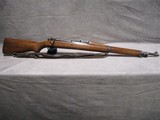
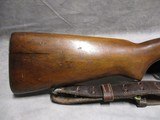
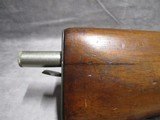
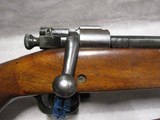
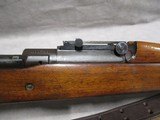
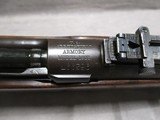
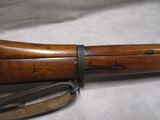
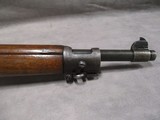
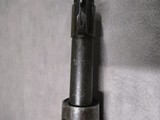
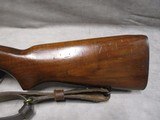
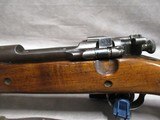
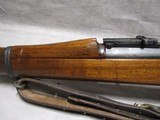
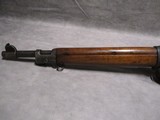
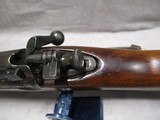
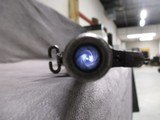
|
Guns International #: 102529453
Category - Springfield Rifles - 1903
- Military Rifles - US
Seller's Information
When emailing or calling sellers direct,
please mention that you saw their listing on GunsInternational.com
Seller: Shooter's Supply, LLC.
Member Since: 3/16/16
First Name: Patrick
Last Name: Brown
State:
Tennessee
Zip: 37343
Country: United States
Phone:
(423) 875-4868
Active Listings: 76
Total Listings: 1350
Seller Type: FFL Dealer
Return Policy: 3 day inspection and return policy on used guns and accessories. No returns on new firearms.
We normally ship USPS Priority Mail which should be 2-day ship. Shipping is actual cost with a minimum of $30.00 for pistols and $50.00 for rifles/shotguns to ship to most of the 48 contiguous states. Shipping to Alaska may require an extra fee. Shipping insurance is available upon request for an extra fee. We cannot do international sales. As of November 2019, we no longer ship guns to California and Hawaii. Payment Methods: Visa, Master Card, American Express, USPS Money Order. NO CREDIT CARD FEES!!!
About Us: We are a small family owned business located in Hixson, Tennessee. Do you have firearms at home collecting dust? We have a lively consignment business. Our fee is 20% with a $50 minimum. Firearms are consigned for a an average period of 180 days but the length of period is negotiable. We also do handgun carry permit classes for the state of Tennessee. We have a nice indoor shooting range with reasonable rates. Please check us out at shooterssupply.
Springfield Model 1903 Low-Serial Number (1906) WW2 Rebuild with Sling, Cleaning Kit
Description: The Model 1903 Springfield rifle was designed to replace the U.S. Army’s Krag Rifle in service. It was built around the one-size-fits-all concept, and so did not have a cavalry/artillery specific model as did the Krag rifle. The M1903 was originally chambered for the .30-03 cartridge, which featured a 64.5mm long case and a 220gr round-nosed bullet. With the introduction of the German 8mm S Patrone and its 154gr Spitzgeschoss or Spire Point Bullet, the US had to follow suit and by 1906 the .30-06 was born (with its 150gr spitzer bullet and slightly shorter 63mm case length). As the Springfield was essentially a Mauser 1898 with a small ring receiver, royalties were paid to Mauser up until the U.S. declared war on Germany in 1917. By the time the US entered WW1 in 1917, 843,239 M1903 rifles had been produced at the Springfield Armory and Rock Island Arsenal. Prior to the entry into war, it had been discovered that the production of the M1903 utilized questionable metallurgy. Some of the receivers constructed using the single-heat-treated method using case-hardened steel were improperly subjected to temperatures well above what was required during the forging process. Essentially, the carbon would be “burnt” out of the steel, resulting in an exceptionally brittle receiver. Contrary to popular belief, while there is documented evidence indicating some early receivers were improperly forged, actual cases of receivers self-destructing were very rare. Although some cases of serious injury resulting from a receiver failing during firing are documented, the U.S. Army never reported any fatalities. Indeed, a large number of the failures were not solely due to the quality of the receiver’s construction, but in fact to what was being loaded into the rifle. Some of the failures were linked to the use of incorrect cartridges such as the 8x57 Mauser. There is also evidence that Winchester may have significantly overloaded some of the .30-06 ammo they produced during the war. Nonetheless, pyrometers were installed in December of 1917 to more accurately measure temperatures during the forging process. The process of heating and quenching the steel was changed as well. This change was made at serial number 800,000 for rifles made at the Springfield Armory and at serial number 285,507 at the Rock Island Arsenal. Rifles with serial numbers lower than 800,000 are commonly referred to as “low-number” 1903s and while those above are termed “high-number” 1903s. The high-number 1903s are said to have been “double-heat treated” which refers to the newer heating/quenching process. Another change was made at serial number 1,275,767 with the introduction of nickel steel, replacing the WD 1325 steel used previously. While the likelihood of failure was low, the low-number 1903s still posed a potential safety risk, and the Ordnance Department withdrew as many of the low-number M1903s as they could find and stored them away. During World War 2, however, the urgent need for rifles resulted in the Ordnance Department’s decision to rebuild and reissue many of the low-number Springfields as well as the high-number ones. Sadly, as is usually the case with rebuilds involving large numbers of guns, the bolts tended to become mixed up during the process. However, telling the difference between a high-number bolt and a low-number bolt is easy. The original low-number bolt features a bolt handle which points directly downward or perpendicular to the length of the receiver. High number bolts, however, feature a bolt handle that is swept backwards at a slight angle. While some of the early high-number receivers came with the vertical bolt, NONE of the low-number receivers came with a swept-back bolt handle when they were originally built. Another major change made to the low-number guns during rebuilding was the replacement of the original straight-grip stock with the newer “Type C” wooden stock with pistol grip. As the rifles were required to be sent out as quickly as possible, the work done for the Type C stock to fit a low-number gun was usually a little crude, with small gaps between the tangs (upper and lower) and the stock itself. The original barrel might also be replaced with a newer one during the rebuild. The rifle shown here is of course one of the low-number rifles rebuilt during World War 2. The receiver was built originally in 1906, the year the .30-06 Springfield and its spitzer bullet replaced the older .30-03 and its 220gr round-nosed bullet. The wear and tear on this rifle is consistent with one that has been used overseas. The barrel was a replacement made by Springfield Armory in July of 1942. The bore of the barrel is in good shape; there are a few miniscule spots of pitting visible near the muzzle, but they are mostly shallow and should not have that much effect on the accuracy of the rifle. The bolt is unsurprisingly a high-number type, given the swept-back bolt handle. The Type C stock has dings and a few dents here and there, and there are gaps behind the receiver tangs although the lower gap is smaller than the one on the top. Please see the pictures. The receiver is in no way loose in the stock, but the appearance is certainly unusual for a an M1903. The letter “K” is stamped into the recess for the magazine cutoff switch. This is the only stamp that can be visibly seen on the stock, so it is likely the stock was refinished at some point. The buttstock has a slim crack on the right-hand side that does NOT appear to have passed through to the other side. Repairing this should be fairly straightforward. The receiver, thankfully, has NOT been drilled and tapped. The condition of the 03’s finish is what would be expected of a rifle that saw service during wartime. There is a set of scratches on the rear sight collar. The rifle appears to have been cleaned of any rust on the external surfaces. There is a cleaning kit tube in the butt stock storage space. The leather sling is stamped “Hoyt 1917”, and its appearance encourages the belief that it is at least original to the era if not original to the rifle. SOLD Rifle Caliber: .30-06 Springfield Manufacturer: Springfield Arsenal Model: Model 1903 Serial Number: 166396 Bore: Rifled, 4 grooves, 1:10 inches (1 in 254 mm) RH twist Ejectors: Manual ejection via operation of the bolt Condition: Used - Good Barrels: Nickel steel Barrel Type: WW2 4-groove type Action: Bolt action, Mauser ’98-style action with CRF Triggers: Standard M1903 trigger Stock: Type C wooden stock Fore End: Wood Butt Pad: Metal plate with trap door LOP: 13.0 inches (330 mm) Finish: Parkerized Weight: 8.0 lbs. unloaded Sights: M1905 Ladder type rear sight, blade front sight, sight radius 21.625 inches (549.275 mm) Manufacture Date: 1906 |
Guns International #: 102529453
Seller's Inventory #: 2312-0068
Category - Springfield Rifles - 1903
- Military Rifles - US
Seller's Information
When emailing or calling sellers direct,
please mention that you saw their listing on GunsInternational.com
Seller: Shooter's Supply, LLC.
Member Since: 3/16/16
First Name: Patrick
Last Name: Brown
State:
Tennessee
Zip: 37343
Country: United States
Phone:
(423) 875-4868
Active Listings: 76
Total Listings: 1350
Seller Type: FFL Dealer
Return Policy: 3 day inspection and return policy on used guns and accessories. No returns on new firearms.
We normally ship USPS Priority Mail which should be 2-day ship. Shipping is actual cost with a minimum of $30.00 for pistols and $50.00 for rifles/shotguns to ship to most of the 48 contiguous states. Shipping to Alaska may require an extra fee. Shipping insurance is available upon request for an extra fee. We cannot do international sales. As of November 2019, we no longer ship guns to California and Hawaii.
We normally ship USPS Priority Mail which should be 2-day ship. Shipping is actual cost with a minimum of $30.00 for pistols and $50.00 for rifles/shotguns to ship to most of the 48 contiguous states. Shipping to Alaska may require an extra fee. Shipping insurance is available upon request for an extra fee. We cannot do international sales. As of November 2019, we no longer ship guns to California and Hawaii.
Payment Methods: Visa, Master Card, American Express, USPS Money Order. NO CREDIT CARD FEES!!!
About Us: We are a small family owned business located in Hixson, Tennessee. Do you have firearms at home collecting dust? We have a lively consignment business. Our fee is 20% with a $50 minimum. Firearms are consigned for a an average period of 180 days but the length of period is negotiable. We also do handgun carry permit classes for the state of Tennessee. We have a nice indoor shooting range with reasonable rates. Please check us out at shooterssupply.
Springfield Model 1903 Low-Serial Number (1906) WW2 Rebuild with Sling, Cleaning Kit
Description:
The Model 1903 Springfield rifle was designed to replace the U.S. Army’s Krag Rifle in service. It was built around the one-size-fits-all concept, and so did not have a cavalry/artillery specific model as did the Krag rifle. The M1903 was originally chambered for the .30-03 cartridge, which featured a 64.5mm long case and a 220gr round-nosed bullet. With the introduction of the German 8mm S Patrone and its 154gr Spitzgeschoss or Spire Point Bullet, the US had to follow suit and by 1906 the .30-06 was born (with its 150gr spitzer bullet and slightly shorter 63mm case length). As the Springfield was essentially a Mauser 1898 with a small ring receiver, royalties were paid to Mauser up until the U.S. declared war on Germany in 1917. By the time the US entered WW1 in 1917, 843,239 M1903 rifles had been produced at the Springfield Armory and Rock Island Arsenal.
Prior to the entry into war, it had been discovered that the production of the M1903 utilized questionable metallurgy. Some of the receivers constructed using the single-heat-treated method using case-hardened steel were improperly subjected to temperatures well above what was required during the forging process. Essentially, the carbon would be “burnt” out of the steel, resulting in an exceptionally brittle receiver. Contrary to popular belief, while there is documented evidence indicating some early receivers were improperly forged, actual cases of receivers self-destructing were very rare. Although some cases of serious injury resulting from a receiver failing during firing are documented, the U.S. Army never reported any fatalities. Indeed, a large number of the failures were not solely due to the quality of the receiver’s construction, but in fact to what was being loaded into the rifle. Some of the failures were linked to the use of incorrect cartridges such as the 8x57 Mauser. There is also evidence that Winchester may have significantly overloaded some of the .30-06 ammo they produced during the war. Nonetheless, pyrometers were installed in December of 1917 to more accurately measure temperatures during the forging process. The process of heating and quenching the steel was changed as well. This change was made at serial number 800,000 for rifles made at the Springfield Armory and at serial number 285,507 at the Rock Island Arsenal. Rifles with serial numbers lower than 800,000 are commonly referred to as “low-number” 1903s and while those above are termed “high-number” 1903s. The high-number 1903s are said to have been “double-heat treated” which refers to the newer heating/quenching process. Another change was made at serial number 1,275,767 with the introduction of nickel steel, replacing the WD 1325 steel used previously. While the likelihood of failure was low, the low-number 1903s still posed a potential safety risk, and the Ordnance Department withdrew as many of the low-number M1903s as they could find and stored them away. During World War 2, however, the urgent need for rifles resulted in the Ordnance Department’s decision to rebuild and reissue many of the low-number Springfields as well as the high-number ones. Sadly, as is usually the case with rebuilds involving large numbers of guns, the bolts tended to become mixed up during the process. However, telling the difference between a high-number bolt and a low-number bolt is easy. The original low-number bolt features a bolt handle which points directly downward or perpendicular to the length of the receiver. High number bolts, however, feature a bolt handle that is swept backwards at a slight angle. While some of the early high-number receivers came with the vertical bolt, NONE of the low-number receivers came with a swept-back bolt handle when they were originally built. Another major change made to the low-number guns during rebuilding was the replacement of the original straight-grip stock with the newer “Type C” wooden stock with pistol grip. As the rifles were required to be sent out as quickly as possible, the work done for the Type C stock to fit a low-number gun was usually a little crude, with small gaps between the tangs (upper and lower) and the stock itself. The original barrel might also be replaced with a newer one during the rebuild.
The rifle shown here is of course one of the low-number rifles rebuilt during World War 2. The receiver was built originally in 1906, the year the .30-06 Springfield and its spitzer bullet replaced the older .30-03 and its 220gr round-nosed bullet. The wear and tear on this rifle is consistent with one that has been used overseas. The barrel was a replacement made by Springfield Armory in July of 1942. The bore of the barrel is in good shape; there are a few miniscule spots of pitting visible near the muzzle, but they are mostly shallow and should not have that much effect on the accuracy of the rifle. The bolt is unsurprisingly a high-number type, given the swept-back bolt handle. The Type C stock has dings and a few dents here and there, and there are gaps behind the receiver tangs although the lower gap is smaller than the one on the top. Please see the pictures. The receiver is in no way loose in the stock, but the appearance is certainly unusual for a an M1903. The letter “K” is stamped into the recess for the magazine cutoff switch. This is the only stamp that can be visibly seen on the stock, so it is likely the stock was refinished at some point. The buttstock has a slim crack on the right-hand side that does NOT appear to have passed through to the other side. Repairing this should be fairly straightforward. The receiver, thankfully, has NOT been drilled and tapped. The condition of the 03’s finish is what would be expected of a rifle that saw service during wartime. There is a set of scratches on the rear sight collar. The rifle appears to have been cleaned of any rust on the external surfaces. There is a cleaning kit tube in the butt stock storage space. The leather sling is stamped “Hoyt 1917”, and its appearance encourages the belief that it is at least original to the era if not original to the rifle.
SOLD
Rifle Caliber: .30-06 Springfield
Manufacturer: Springfield Arsenal
Model: Model 1903
Serial Number: 166396
Bore: Rifled, 4 grooves, 1:10 inches (1 in 254 mm) RH twist
Ejectors: Manual ejection via operation of the bolt
Condition: Used - Good
Barrels: Nickel steel
Barrel Type: WW2 4-groove type
Action: Bolt action, Mauser ’98-style action with CRF
Triggers: Standard M1903 trigger
Stock: Type C wooden stock
Fore End: Wood
Butt Pad: Metal plate with trap door
LOP: 13.0 inches (330 mm)
Finish: Parkerized
Weight: 8.0 lbs. unloaded
Sights: M1905 Ladder type rear sight, blade front sight, sight radius 21.625 inches (549.275 mm)
Manufacture Date: 1906
Description:
The Model 1903 Springfield rifle was designed to replace the U.S. Army’s Krag Rifle in service. It was built around the one-size-fits-all concept, and so did not have a cavalry/artillery specific model as did the Krag rifle. The M1903 was originally chambered for the .30-03 cartridge, which featured a 64.5mm long case and a 220gr round-nosed bullet. With the introduction of the German 8mm S Patrone and its 154gr Spitzgeschoss or Spire Point Bullet, the US had to follow suit and by 1906 the .30-06 was born (with its 150gr spitzer bullet and slightly shorter 63mm case length). As the Springfield was essentially a Mauser 1898 with a small ring receiver, royalties were paid to Mauser up until the U.S. declared war on Germany in 1917. By the time the US entered WW1 in 1917, 843,239 M1903 rifles had been produced at the Springfield Armory and Rock Island Arsenal.
Prior to the entry into war, it had been discovered that the production of the M1903 utilized questionable metallurgy. Some of the receivers constructed using the single-heat-treated method using case-hardened steel were improperly subjected to temperatures well above what was required during the forging process. Essentially, the carbon would be “burnt” out of the steel, resulting in an exceptionally brittle receiver. Contrary to popular belief, while there is documented evidence indicating some early receivers were improperly forged, actual cases of receivers self-destructing were very rare. Although some cases of serious injury resulting from a receiver failing during firing are documented, the U.S. Army never reported any fatalities. Indeed, a large number of the failures were not solely due to the quality of the receiver’s construction, but in fact to what was being loaded into the rifle. Some of the failures were linked to the use of incorrect cartridges such as the 8x57 Mauser. There is also evidence that Winchester may have significantly overloaded some of the .30-06 ammo they produced during the war. Nonetheless, pyrometers were installed in December of 1917 to more accurately measure temperatures during the forging process. The process of heating and quenching the steel was changed as well. This change was made at serial number 800,000 for rifles made at the Springfield Armory and at serial number 285,507 at the Rock Island Arsenal. Rifles with serial numbers lower than 800,000 are commonly referred to as “low-number” 1903s and while those above are termed “high-number” 1903s. The high-number 1903s are said to have been “double-heat treated” which refers to the newer heating/quenching process. Another change was made at serial number 1,275,767 with the introduction of nickel steel, replacing the WD 1325 steel used previously. While the likelihood of failure was low, the low-number 1903s still posed a potential safety risk, and the Ordnance Department withdrew as many of the low-number M1903s as they could find and stored them away. During World War 2, however, the urgent need for rifles resulted in the Ordnance Department’s decision to rebuild and reissue many of the low-number Springfields as well as the high-number ones. Sadly, as is usually the case with rebuilds involving large numbers of guns, the bolts tended to become mixed up during the process. However, telling the difference between a high-number bolt and a low-number bolt is easy. The original low-number bolt features a bolt handle which points directly downward or perpendicular to the length of the receiver. High number bolts, however, feature a bolt handle that is swept backwards at a slight angle. While some of the early high-number receivers came with the vertical bolt, NONE of the low-number receivers came with a swept-back bolt handle when they were originally built. Another major change made to the low-number guns during rebuilding was the replacement of the original straight-grip stock with the newer “Type C” wooden stock with pistol grip. As the rifles were required to be sent out as quickly as possible, the work done for the Type C stock to fit a low-number gun was usually a little crude, with small gaps between the tangs (upper and lower) and the stock itself. The original barrel might also be replaced with a newer one during the rebuild.
The rifle shown here is of course one of the low-number rifles rebuilt during World War 2. The receiver was built originally in 1906, the year the .30-06 Springfield and its spitzer bullet replaced the older .30-03 and its 220gr round-nosed bullet. The wear and tear on this rifle is consistent with one that has been used overseas. The barrel was a replacement made by Springfield Armory in July of 1942. The bore of the barrel is in good shape; there are a few miniscule spots of pitting visible near the muzzle, but they are mostly shallow and should not have that much effect on the accuracy of the rifle. The bolt is unsurprisingly a high-number type, given the swept-back bolt handle. The Type C stock has dings and a few dents here and there, and there are gaps behind the receiver tangs although the lower gap is smaller than the one on the top. Please see the pictures. The receiver is in no way loose in the stock, but the appearance is certainly unusual for a an M1903. The letter “K” is stamped into the recess for the magazine cutoff switch. This is the only stamp that can be visibly seen on the stock, so it is likely the stock was refinished at some point. The buttstock has a slim crack on the right-hand side that does NOT appear to have passed through to the other side. Repairing this should be fairly straightforward. The receiver, thankfully, has NOT been drilled and tapped. The condition of the 03’s finish is what would be expected of a rifle that saw service during wartime. There is a set of scratches on the rear sight collar. The rifle appears to have been cleaned of any rust on the external surfaces. There is a cleaning kit tube in the butt stock storage space. The leather sling is stamped “Hoyt 1917”, and its appearance encourages the belief that it is at least original to the era if not original to the rifle.
SOLD
Rifle Caliber: .30-06 Springfield
Manufacturer: Springfield Arsenal
Model: Model 1903
Serial Number: 166396
Bore: Rifled, 4 grooves, 1:10 inches (1 in 254 mm) RH twist
Ejectors: Manual ejection via operation of the bolt
Condition: Used - Good
Barrels: Nickel steel
Barrel Type: WW2 4-groove type
Action: Bolt action, Mauser ’98-style action with CRF
Triggers: Standard M1903 trigger
Stock: Type C wooden stock
Fore End: Wood
Butt Pad: Metal plate with trap door
LOP: 13.0 inches (330 mm)
Finish: Parkerized
Weight: 8.0 lbs. unloaded
Sights: M1905 Ladder type rear sight, blade front sight, sight radius 21.625 inches (549.275 mm)
Manufacture Date: 1906
Guns International #: 102529453
Seller's Inventory #: 2312-0068


Guns International #: 102529453
Seller's Inventory #: 2312-0068
Category - Springfield Rifles - 1903
- Military Rifles - US
Seller's Information
When emailing or calling sellers direct,
please mention that you saw their listing on GunsInternational.com
Seller: Shooter's Supply, LLC.
Member Since: 3/16/16
First Name: Patrick
Last Name: Brown
State:
Tennessee
Zip: 37343
Country: United States
Phone:
(423) 875-4868
Active Listings: 76
Total Listings: 1350
Seller Type: FFL Dealer
Return Policy: 3 day inspection and return policy on used guns and accessories. No returns on new firearms.
We normally ship USPS Priority Mail which should be 2-day ship. Shipping is actual cost with a minimum of $30.00 for pistols and $50.00 for rifles/shotguns to ship to most of the 48 contiguous states. Shipping to Alaska may require an extra fee. Shipping insurance is available upon request for an extra fee. We cannot do international sales. As of November 2019, we no longer ship guns to California and Hawaii.
We normally ship USPS Priority Mail which should be 2-day ship. Shipping is actual cost with a minimum of $30.00 for pistols and $50.00 for rifles/shotguns to ship to most of the 48 contiguous states. Shipping to Alaska may require an extra fee. Shipping insurance is available upon request for an extra fee. We cannot do international sales. As of November 2019, we no longer ship guns to California and Hawaii.
Payment Methods: Visa, Master Card, American Express, USPS Money Order. NO CREDIT CARD FEES!!!
About Us: We are a small family owned business located in Hixson, Tennessee. Do you have firearms at home collecting dust? We have a lively consignment business. Our fee is 20% with a $50 minimum. Firearms are consigned for a an average period of 180 days but the length of period is negotiable. We also do handgun carry permit classes for the state of Tennessee. We have a nice indoor shooting range with reasonable rates. Please check us out at shooterssupply.
Springfield Model 1903 Low-Serial Number (1906) WW2 Rebuild with Sling, Cleaning Kit
Description:
The Model 1903 Springfield rifle was designed to replace the U.S. Army’s Krag Rifle in service. It was built around the one-size-fits-all concept, and so did not have a cavalry/artillery specific model as did the Krag rifle. The M1903 was originally chambered for the .30-03 cartridge, which featured a 64.5mm long case and a 220gr round-nosed bullet. With the introduction of the German 8mm S Patrone and its 154gr Spitzgeschoss or Spire Point Bullet, the US had to follow suit and by 1906 the .30-06 was born (with its 150gr spitzer bullet and slightly shorter 63mm case length). As the Springfield was essentially a Mauser 1898 with a small ring receiver, royalties were paid to Mauser up until the U.S. declared war on Germany in 1917. By the time the US entered WW1 in 1917, 843,239 M1903 rifles had been produced at the Springfield Armory and Rock Island Arsenal.
Prior to the entry into war, it had been discovered that the production of the M1903 utilized questionable metallurgy. Some of the receivers constructed using the single-heat-treated method using case-hardened steel were improperly subjected to temperatures well above what was required during the forging process. Essentially, the carbon would be “burnt” out of the steel, resulting in an exceptionally brittle receiver. Contrary to popular belief, while there is documented evidence indicating some early receivers were improperly forged, actual cases of receivers self-destructing were very rare. Although some cases of serious injury resulting from a receiver failing during firing are documented, the U.S. Army never reported any fatalities. Indeed, a large number of the failures were not solely due to the quality of the receiver’s construction, but in fact to what was being loaded into the rifle. Some of the failures were linked to the use of incorrect cartridges such as the 8x57 Mauser. There is also evidence that Winchester may have significantly overloaded some of the .30-06 ammo they produced during the war. Nonetheless, pyrometers were installed in December of 1917 to more accurately measure temperatures during the forging process. The process of heating and quenching the steel was changed as well. This change was made at serial number 800,000 for rifles made at the Springfield Armory and at serial number 285,507 at the Rock Island Arsenal. Rifles with serial numbers lower than 800,000 are commonly referred to as “low-number” 1903s and while those above are termed “high-number” 1903s. The high-number 1903s are said to have been “double-heat treated” which refers to the newer heating/quenching process. Another change was made at serial number 1,275,767 with the introduction of nickel steel, replacing the WD 1325 steel used previously. While the likelihood of failure was low, the low-number 1903s still posed a potential safety risk, and the Ordnance Department withdrew as many of the low-number M1903s as they could find and stored them away. During World War 2, however, the urgent need for rifles resulted in the Ordnance Department’s decision to rebuild and reissue many of the low-number Springfields as well as the high-number ones. Sadly, as is usually the case with rebuilds involving large numbers of guns, the bolts tended to become mixed up during the process. However, telling the difference between a high-number bolt and a low-number bolt is easy. The original low-number bolt features a bolt handle which points directly downward or perpendicular to the length of the receiver. High number bolts, however, feature a bolt handle that is swept backwards at a slight angle. While some of the early high-number receivers came with the vertical bolt, NONE of the low-number receivers came with a swept-back bolt handle when they were originally built. Another major change made to the low-number guns during rebuilding was the replacement of the original straight-grip stock with the newer “Type C” wooden stock with pistol grip. As the rifles were required to be sent out as quickly as possible, the work done for the Type C stock to fit a low-number gun was usually a little crude, with small gaps between the tangs (upper and lower) and the stock itself. The original barrel might also be replaced with a newer one during the rebuild.
The rifle shown here is of course one of the low-number rifles rebuilt during World War 2. The receiver was built originally in 1906, the year the .30-06 Springfield and its spitzer bullet replaced the older .30-03 and its 220gr round-nosed bullet. The wear and tear on this rifle is consistent with one that has been used overseas. The barrel was a replacement made by Springfield Armory in July of 1942. The bore of the barrel is in good shape; there are a few miniscule spots of pitting visible near the muzzle, but they are mostly shallow and should not have that much effect on the accuracy of the rifle. The bolt is unsurprisingly a high-number type, given the swept-back bolt handle. The Type C stock has dings and a few dents here and there, and there are gaps behind the receiver tangs although the lower gap is smaller than the one on the top. Please see the pictures. The receiver is in no way loose in the stock, but the appearance is certainly unusual for a an M1903. The letter “K” is stamped into the recess for the magazine cutoff switch. This is the only stamp that can be visibly seen on the stock, so it is likely the stock was refinished at some point. The buttstock has a slim crack on the right-hand side that does NOT appear to have passed through to the other side. Repairing this should be fairly straightforward. The receiver, thankfully, has NOT been drilled and tapped. The condition of the 03’s finish is what would be expected of a rifle that saw service during wartime. There is a set of scratches on the rear sight collar. The rifle appears to have been cleaned of any rust on the external surfaces. There is a cleaning kit tube in the butt stock storage space. The leather sling is stamped “Hoyt 1917”, and its appearance encourages the belief that it is at least original to the era if not original to the rifle.
SOLD
Rifle Caliber: .30-06 Springfield
Manufacturer: Springfield Arsenal
Model: Model 1903
Serial Number: 166396
Bore: Rifled, 4 grooves, 1:10 inches (1 in 254 mm) RH twist
Ejectors: Manual ejection via operation of the bolt
Condition: Used - Good
Barrels: Nickel steel
Barrel Type: WW2 4-groove type
Action: Bolt action, Mauser ’98-style action with CRF
Triggers: Standard M1903 trigger
Stock: Type C wooden stock
Fore End: Wood
Butt Pad: Metal plate with trap door
LOP: 13.0 inches (330 mm)
Finish: Parkerized
Weight: 8.0 lbs. unloaded
Sights: M1905 Ladder type rear sight, blade front sight, sight radius 21.625 inches (549.275 mm)
Manufacture Date: 1906
Description:
The Model 1903 Springfield rifle was designed to replace the U.S. Army’s Krag Rifle in service. It was built around the one-size-fits-all concept, and so did not have a cavalry/artillery specific model as did the Krag rifle. The M1903 was originally chambered for the .30-03 cartridge, which featured a 64.5mm long case and a 220gr round-nosed bullet. With the introduction of the German 8mm S Patrone and its 154gr Spitzgeschoss or Spire Point Bullet, the US had to follow suit and by 1906 the .30-06 was born (with its 150gr spitzer bullet and slightly shorter 63mm case length). As the Springfield was essentially a Mauser 1898 with a small ring receiver, royalties were paid to Mauser up until the U.S. declared war on Germany in 1917. By the time the US entered WW1 in 1917, 843,239 M1903 rifles had been produced at the Springfield Armory and Rock Island Arsenal.
Prior to the entry into war, it had been discovered that the production of the M1903 utilized questionable metallurgy. Some of the receivers constructed using the single-heat-treated method using case-hardened steel were improperly subjected to temperatures well above what was required during the forging process. Essentially, the carbon would be “burnt” out of the steel, resulting in an exceptionally brittle receiver. Contrary to popular belief, while there is documented evidence indicating some early receivers were improperly forged, actual cases of receivers self-destructing were very rare. Although some cases of serious injury resulting from a receiver failing during firing are documented, the U.S. Army never reported any fatalities. Indeed, a large number of the failures were not solely due to the quality of the receiver’s construction, but in fact to what was being loaded into the rifle. Some of the failures were linked to the use of incorrect cartridges such as the 8x57 Mauser. There is also evidence that Winchester may have significantly overloaded some of the .30-06 ammo they produced during the war. Nonetheless, pyrometers were installed in December of 1917 to more accurately measure temperatures during the forging process. The process of heating and quenching the steel was changed as well. This change was made at serial number 800,000 for rifles made at the Springfield Armory and at serial number 285,507 at the Rock Island Arsenal. Rifles with serial numbers lower than 800,000 are commonly referred to as “low-number” 1903s and while those above are termed “high-number” 1903s. The high-number 1903s are said to have been “double-heat treated” which refers to the newer heating/quenching process. Another change was made at serial number 1,275,767 with the introduction of nickel steel, replacing the WD 1325 steel used previously. While the likelihood of failure was low, the low-number 1903s still posed a potential safety risk, and the Ordnance Department withdrew as many of the low-number M1903s as they could find and stored them away. During World War 2, however, the urgent need for rifles resulted in the Ordnance Department’s decision to rebuild and reissue many of the low-number Springfields as well as the high-number ones. Sadly, as is usually the case with rebuilds involving large numbers of guns, the bolts tended to become mixed up during the process. However, telling the difference between a high-number bolt and a low-number bolt is easy. The original low-number bolt features a bolt handle which points directly downward or perpendicular to the length of the receiver. High number bolts, however, feature a bolt handle that is swept backwards at a slight angle. While some of the early high-number receivers came with the vertical bolt, NONE of the low-number receivers came with a swept-back bolt handle when they were originally built. Another major change made to the low-number guns during rebuilding was the replacement of the original straight-grip stock with the newer “Type C” wooden stock with pistol grip. As the rifles were required to be sent out as quickly as possible, the work done for the Type C stock to fit a low-number gun was usually a little crude, with small gaps between the tangs (upper and lower) and the stock itself. The original barrel might also be replaced with a newer one during the rebuild.
The rifle shown here is of course one of the low-number rifles rebuilt during World War 2. The receiver was built originally in 1906, the year the .30-06 Springfield and its spitzer bullet replaced the older .30-03 and its 220gr round-nosed bullet. The wear and tear on this rifle is consistent with one that has been used overseas. The barrel was a replacement made by Springfield Armory in July of 1942. The bore of the barrel is in good shape; there are a few miniscule spots of pitting visible near the muzzle, but they are mostly shallow and should not have that much effect on the accuracy of the rifle. The bolt is unsurprisingly a high-number type, given the swept-back bolt handle. The Type C stock has dings and a few dents here and there, and there are gaps behind the receiver tangs although the lower gap is smaller than the one on the top. Please see the pictures. The receiver is in no way loose in the stock, but the appearance is certainly unusual for a an M1903. The letter “K” is stamped into the recess for the magazine cutoff switch. This is the only stamp that can be visibly seen on the stock, so it is likely the stock was refinished at some point. The buttstock has a slim crack on the right-hand side that does NOT appear to have passed through to the other side. Repairing this should be fairly straightforward. The receiver, thankfully, has NOT been drilled and tapped. The condition of the 03’s finish is what would be expected of a rifle that saw service during wartime. There is a set of scratches on the rear sight collar. The rifle appears to have been cleaned of any rust on the external surfaces. There is a cleaning kit tube in the butt stock storage space. The leather sling is stamped “Hoyt 1917”, and its appearance encourages the belief that it is at least original to the era if not original to the rifle.
SOLD
Rifle Caliber: .30-06 Springfield
Manufacturer: Springfield Arsenal
Model: Model 1903
Serial Number: 166396
Bore: Rifled, 4 grooves, 1:10 inches (1 in 254 mm) RH twist
Ejectors: Manual ejection via operation of the bolt
Condition: Used - Good
Barrels: Nickel steel
Barrel Type: WW2 4-groove type
Action: Bolt action, Mauser ’98-style action with CRF
Triggers: Standard M1903 trigger
Stock: Type C wooden stock
Fore End: Wood
Butt Pad: Metal plate with trap door
LOP: 13.0 inches (330 mm)
Finish: Parkerized
Weight: 8.0 lbs. unloaded
Sights: M1905 Ladder type rear sight, blade front sight, sight radius 21.625 inches (549.275 mm)
Manufacture Date: 1906
Guns International Advertising Policy
GunsInternational.com is the #1 Gun Classified website that brings gun buyers and gun brokers or sellers together through classifed advertising of guns, gun related items and services for sale online. If you are looking to buy guns or sell guns, you have come to the right place. GunsInternational.com gun classifieds currently have over 100,000 guns for sale online by numerous dealers and collectors alike. Guns International makes no representation or warranty as to the accuracy of the information contained in the gun classifieds, gun parts or gun services classifieds listings. Buyers and sellers are required to know and comply with all applicable local, state, federal and international firearm laws.
GunsInternational.com is the #1 Gun Classified website that brings gun buyers and gun brokers or sellers together through classifed advertising of guns, gun related items and services for sale online. If you are looking to buy guns or sell guns, you have come to the right place. GunsInternational.com gun classifieds currently have over 100,000 guns for sale online by numerous dealers and collectors alike. Guns International makes no representation or warranty as to the accuracy of the information contained in the gun classifieds, gun parts or gun services classifieds listings. Buyers and sellers are required to know and comply with all applicable local, state, federal and international firearm laws.
Listings
Home
New Today
New This Week
Rifles For Sale Online
Shotguns For Sale Online
Handguns For Sale Online
Pistols For Sale Online
Revolvers For Sale Online
NFA
Gun Parts For Sale Online
Services
Home
New Today
New This Week
Rifles For Sale Online
Shotguns For Sale Online
Handguns For Sale Online
Pistols For Sale Online
Revolvers For Sale Online
NFA
Gun Parts For Sale Online
Services
©2006 - 2025 all rights reserved. | Guns International.com | V4.1 ww2



Privacy Policy
User Agreement
FAQs
Contact Us
©2006 - 2025 all rights reserved.
Guns International.com | V4.1 ww2
Guns International.com | V4.1 ww2

